Infotainment systems have long helped make our everyday experiences – in cars and airplanes, elevators and public spaces – more enjoyable, with convenient access to music, films, and other casual entertainment. As hardware and software advanced, these systems evolved to make it easier than ever to access our favorite films, books, and magazines as well as critical trip information – such as schedule changes, travel conditions, and destination updates.
Today, these systems are increasingly built with rugged electronic components for robust data, power, and signal connectivity. These components are making it possible to evolve the technology beyond the simple information-and-entertainment-hub concept into becoming a crucial part of the architecture in the devices, machines, and networks that are changing how we travel, live, and communicate.
To meet the increasingly global expectation for technological integration, engineers are applying Internet-of-Things (IoT) thinking to enable greater end-to-end connectivity. To achieve this, they are building high-bandwidth, low-latency systems offering the capacity to operate reliably in variable-temperature environments and high-vibration applications – connected cars and aircraft, long-haul trucks and trains, and building systems and cityscapes. At the forefront of this evolution is the next-generation infotainment application.

Today's electronic components enable robust end-to-end connectivity in communications systems, creating opportunities for next-generation infotainment technology.
The current generation of advanced infotainment systems are equipped with miniaturized connectors and lightweight fiber optics. The more future-ready systems are built with embedded antennas for enabling 5G communications as well as multi-function sensors for acquiring and using data. These kinds of electronic components make it possible for engineers to design high-bandwidth, always-on infotainment systems.
With components for high-speed data connectivity, engineers could soon develop highly interactive interfaces that display complex 3D visualizations integrating real-time information, on-demand entertainment, and artificial intelligence. As the technology for data integration evolves, these systems may one day enable immersive digitial experiences that transform physical spaces and enable dynamic multiscreen storytelling through smart audio-visual (A/V) technology and mobile virtual reality (VR) and augmented reality (AR) devices.
By making infotainment systems smarter and a vital part of hyperscale technological ecosystems, these components can transform how we communicate, enabling opportunities to develop efficient, always-on technology that could make possible dynamic sensing, holographic engagement, and predictive programming.
Today at TE Connectivity (TE), we design and manufacture a broad portfolio of rugged, lightweight, and miniaturized components for accelerating data flow, protecting and managing power distribution, and improving signal clarity. In partnering globally with manufacturers small and large, we are helping engineers achieve quick-turn innovation for infotainment systems that can run faster and continuously, while using less power and delivering high-clarity performance with expanded functionality. Getting this right – in ways that also generate new business value – begins with understanding the kinds of electronic components needed to both enable robust end-to-end connectivity in next-generation infotainment systems and integrate these systems into the core architectures for technological ecosystems.
Choosing the Right Components
It begins with understanding how much data the system will need to handle. This will determine which types of electrical and mechanical components – connectors, sensors, cables, antennas, and more – are needed to get the bandwidth and speed required to efficiently run and effectively protect the infotainment system, particularly in complex technological ecosystems such as airplanes, office towers, and cityscapes.
For example, to increase Power over Ethernet (PoE) performance in airplanes and trains, the best choice is twisted pair cables (i.e., differential pairs) – the basis for all Ethernet cabling methods. With twisted pair cables, engineers can efficiently minimize cross-talk (XT) interference between internal wires and alien cross-talk (AXT) between external wires, while increasing PoE by transmitting power alongside data. This means less cabling is used – a simple way to reduce total size and weight (and reduce operating costs) while still providing enough power to meet higher electrical loads required for expanded functionality.
Another crucial decision is choosing between shielded cable and unshielded cable. Determining the best option is only possible after the design team understands all the requirements for protecting the system from electromagnetic interference (EMI). This includes knowing where and how the cable will be used and how the cable affects system reliability, longevity, overall size and weight, and temperature and vibration performance. Putting the right type of cable in the right place will lead to a system that is light yet rugged, easy-to-install, and capable of reliable long-term performance without unexpected service disruptions and excessive maintenance.

End-to-end connectivity in infotainment applications could transform how we access and use data to experience the world.
After the right cable is selected, engineers need to carefully choose the connectors setup for reliable, repeatable connections between switches and terminal equipment. Making this happen begins with knowing the differences between connectors. For example, RJ45 connectors are commonly used to establish Ethernet connections on personal computers; but in a high-vibration application, the infotainment system needs more rugged components. Two reliable choices are the heavy-duty M12 connector and the smaller, versatile M8 connector. Both offer a screw thread for making lock-into-place connections, and both are designed with standard arrangements of pins and sockets – also known as codings – to form the secure connections necessary for continuous, high-clarity communications in long-haul trucks and both regional and cross-continental trains. Our M12 and M8 connectors are also engineered to meet stringent safety standards for low smoke and toxicity and manufactured to withstand shock, vibration, pollution, and extreme temperatures and moisture.
As 5G networks roll out over the next few years, and generally accepted standards are put into place, this technology will – at a minimum – create device-to-device communication that provides people with faster, better access to information; more importantly, it will spearhead a digital evolution that enables flexible networks for integrating technology. The backbone enabling this evolution are embedded antennas for 5G communications.
Available as standard-design antennas and custom-design antennas, this embedded technology gives OEMs the opportunity to create ultralow-latency communications across networked devices. As more technology becomes IoT-enabled, and thousands of devices and systems connect simultaneously at exceptionally fast speeds, engineers will need to anticipate how 5G networks will impact data transmission. They will also need to understand how 5G can enable ultralow end-to-end latency – and how this will affect the market competitiveness of both OEMs and their customers, including car manufacturers, airlines, bus and trucking companies, transit authorities, large-building owners, and municipalities.
The use of 5G antennas will determine the overall signal and power performance of infotainment systems. To attain the desired speeds and lower costs over time, some engineers are developing radios with the capacity to operate in the 15 GHz bands. The challenge in achieving the expected performance is that embedded antennas are often mistakenly thought of as stand-alone passive components, like resistors or capacitors.
With infotainment technology, it is crucial to see that the entire system can be part of the antenna – and that any material or component (near the antenna element, the design of the ground plane, and proximity to sources of in-band noise) can influence antenna performance. This means thinking differently about the antenna from the beginning and partnering with experts who have successfully developed embedded antennas. It begins with understanding the level of system integration people now expect.
At TE, our antenna experts understand the trends affecting advanced connectivity. They are continuously looking at how the expected increase in wireless traffic will impact the limited spectrum of available frequencies, and how – as spectral efficiency becomes more of a critical design concern – embedded antennas can make transmission paths more sufficient and repeatable. Devising an appropriate antenna solution for 5G communications requires a new approach to thinking through the design challenges – and this begins with including antenna design early in development.
This also applies to sensors design. By detailing – early in design review – what the system will need to measure and detect, and how it can use the massive amounts of data it will acquire to enable greater autonomy, engineers can avoid the kind of late-stage changes which require complex and costly alterations.
By determining from the beginning the kind of technological functionality required, engineers can select the connectivity – cabling, connectors, antennas, and sensors – required to design in more integration and innovation. This type of approach will enable more robust machine-to-machine (M2M) communications and vehicle-to-everything (V2X) networks. It will help manufacturers achieve unique value and exceed market expectations for infotainment performance in cars, airplanes, trucks and buses, trains, and high-traffic buildings and public spaces.

With our broad portfolio of electronic components – including high-speed connectors and innovative sensor combinations, lightweight fiber optic solutions and miniature packaging – engineers can enable faster network speeds in infotainment systems, making possible real-time data integration, greater data aggregation, and autonomous management of complex technology.
Designing In Robust Integration
Infotainment in Automobiles
Over the past decade, infotainment systems in cars have evolved to provide drivers and passengers with quick, easy access to information that offers unprecedented convenience, safety, and in-vehicle wireless communications. Making this possible are smaller, lighter electronic components for high-speed, high-density data and power connectivity. These solutions are enabling engineers to build robust architectures that increasingly enable V2X communication and cloud computing. Getting this level of performance right is a challenge, particularly as manufacturers build vehicles with increasingly complex infrastructures including high-current powertrains. The increased convergence of these two new technologies – accelerated data connectivity and electrification – requires solutions capable of reducing EMI to ensure the high performance of data-dependent infotainment and safety systems. One solution is the use of optical data connectivity technology.
When designing a car’s underlying data connectivity architectures – in both combustion and electric engine vehicles, engineers start by resolving a few specific questions:
- How can engineers avoid crosstalk between circuits, especially electrified circuits?
- How do they build a network that has the power to transmit large amounts of data without boundaries?
- How do they ensure the safety and reliability of the transmitted data?
- How do they satisfy the on-going requirements for space and weight saving while retaining true automotive robustness?
To increase the volume and speed of data transmitted in the car, engineers can increase the interconnections throughout the vehicle, which increases the size of data packages and consequently requires high bandwidth capabilities. Automotive Ethernet offers the best cost-benefit ratio for achieving this, but it requires an intelligent interconnection solution with the flexibility, space-economy, and performance for differing EMC requirement levels. Our MATEnet miniaturized automotive Ethernet interconnection system offers the required reliability, affordability, scalability, and fully automated handling, with the required automotive-grade robustness, flexibility, and weight reduction for effective connectivity throughout the car.

In cars, data connectivity is becoming a crucial part of the vehicle’s architecture – and creating a technological ecosystem in which cars connect to other vehicles, roadway infrastructure, and communications networks.
As safety-orientated advanced driver assist system (ADAS) applications are added, there are increased inputs to the cloud, from cameras and antennas as well as the surrounding environment and mobile-broadband connectivity. This is increasing data speeds. Optimizing this connectivity requires RF (radio frequency) transmission channels for coaxial and differential connectivity technologies.
Our MATE-AX connector family is engineered for high-speed data in single-ended solutions. It offers RF performance up to a frequency of 20GHz. This also reduces space to meet today’s automotive packaging requirements. The electrical performance meets the link segment and component level signal integrity as well as the EMC requirements. With this, our coaxial cables are designed for safety links with high RF-requirements.
In looking ahead, the next generation of Level 4 and 5 autonomous driving applications will require new electrical and optical solutions. These will include DWG-based (dielectric wave guide) connectors that can support data transmission rates in excess of 24Gbps. At TE, we are continuously developing our data connectivity portfolio to meet manufacturers’ requirements for function, safety, link type, chips, and cable type, as well as industry standards and OEM or Tier1 specifications.
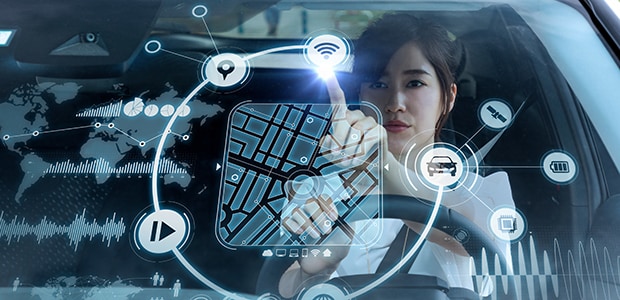
Sensors make it possible for the vehicle to communicate a broad range of information across multiple in-vehicle systems as well as to other vehicles and roadway architecture.
Embedding a variety of sensors into the vehicle enables engineers to design in more autonomy and artificial intelligence – throughout the in-vehicle network. By enabling data acquisition and utilization, sensors make it possible for the vehicle to communicate a broad range of information across multiple in-vehicle systems as well as to other vehicles and roadway architecture. To do this effectively, engineers need to understand the kinds of data which sensors can process:
- Temperature sensors, for monitoring battery and motor conditions
- Speed sensors, for detecting motor performance
- Current sensors, for tracking battery charge/discharge cycles
- Position sensors, for monitoring door locks and windows
- Accelerometers, for measuring vibration and bearing conditions
To meet consumer demand for safer, more connected passenger vehicles, manufacturers are increasingly choosing connectivity solutions that reduce the weight of key systems and support robust, high-clarity communications needed for accelerating data, reducing power, and improving signal to provide more data-driven functionalities – ADAS, as well as pedestrian detection (PD) and lane detection (LD).
This efficiency makes data connectivity a core element in enabling a robust architecture in both combustion-engine and electric-powered cars. And with this, it makes infotainment systems an increasingly crucial part of the vehicle's technological ecosystem, for enabling cars to connect to other vehicles, roadway infrastructure, and communications networks.
To enable crucial systems, engineers are choosing lightweight, miniaturized components that accelerate data, reduce power, and improve signal.
Infotainment in Airplanes
In airplanes, infotainment systems – also known in the industry as Inflight Entertainment (IFE) – have for decades helped passengers enjoy their trip. Today, these systems are increasingly enabling air travelers to connect to the world, wherever they roam. For airlines, this creates opportunities to build loyalty by becoming a great part of customers' lives. For engineers, this means designing in robust and integrated connectivity capable of seamlessly delivering high-clarity, high-speed communications in increasingly smaller, denser packages – without disruption from extreme vibration and temperatures. Achieving this level of connectivity in a vehicle where space is limited and weight impacts power use – and the bottom line – means making infotainment a larger part of an already complex avionic system.
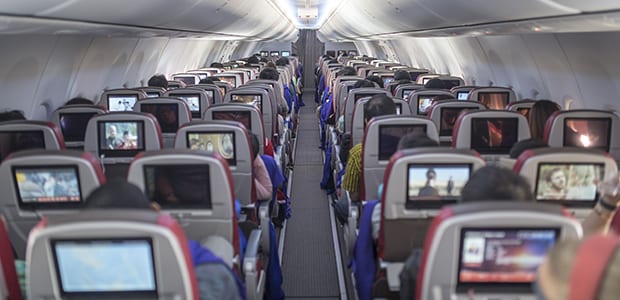
Establishing an inflight Wi-Fi system is particularly challenging, because these are linked by antennas typically located on the top or the bottom of the aircraft.
Today’s aircraft have the capacity to capture and share a great amount of data to improve safety, convenience, and overall performance. Increasingly, engineers are the electrification of the aircraft, by replacing manual controls with both electronic interfaces. For example, inflight data enables pilots to easily monitor and better manage critical aircraft systems. This evolution is possible because of advancements in aerospace connectivity, including TE’s DEUTSCH DMC-M high-speed modular and 369 series connectors, backshells, wire and cabling products, high speed copper wires, Ethernet, and fiber optics.
With these types of electronic components, engineers can design in these kinds of new functionalities. This enables airplane manufacturers to find new ways of generating business value from aircraft technology.
To enable more electrification in critical systems, engineers are embedding more types of electronic components – sensors, connectors, relays, and fiber-optics – throughout the aircraft. For example, the use of electronics in airplanes has risen from 10% of the total cost of airplanes built in the 1980s to 40% of the total cost of today’s aircraft. With this much technology in the airplane, engineers face a critical challenge: Getting enough power into the airplane to run these systems while also reducing the size and weight of the electronic packaging.
The goal is to improve overall efficiency, speed, and cost; the solution is using smaller, lightweight components capable of faster speeds and reliable operation under the harshest conditions – extreme temperatures and vibrations, exposure to elements, and EMI noise and lightning strikes.
To improve the in-flight experience, engineers are increasingly looking for opportunities to integrate more electronic components – particularly sensors – into the aircraft. The sensors data typically is sent to the aircraft’s electronics bay – located at the front of the aircraft. The Electronics Bay is the brains of the in-flight entertainment headend network and the aircraft’s core electronics, where information is collected, processed and distributed throughout the aircraft and to passengers.
The electrical and optical cabling in these systems, including the aircraft’s power source, typically run along the overhead space or beneath the flooring, and then connect to overhead monitors and individual seats, depending upon the specific aircraft configuration and infotainment system architecture. This complex network of embedded and Wi-Fi-enabled technology allows passengers to enjoy many conveniences directly from their seat in the airplane.
Establishing an inflight Wi-Fi system is particularly challenging, because these are linked by antennas typically located on the top or the bottom of the aircraft. To deliver cloud connectivity, the antennas must connect to either a satellite or ground cell tower. Despite the appearance of wireless connectivity, it is important to remember that this Wi-Fi is not totally wireless: the data gathered often travels through the headend servers inside the aircraft and is then distributed along high-speed copper and fiber optic components that connect to the cabin wireless access points (CWAPS).
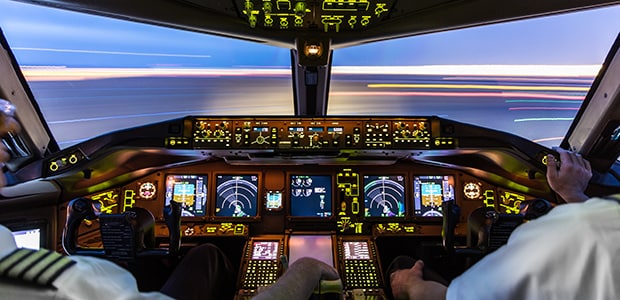
To enable more electrification in critical systems, engineers are embedding more types of electronic components – sensors, connectors, relays, and fiber-optics – throughout the aircraft.
To put more reliability into this kind of system, engineers are developing robust box-to-box connectivity. Copper cables are traditionally used for links that require relatively slow speeds over short distances. But with the rising demand for faster data speeds, engineers are starting to use higher-speed interconnects. This produces an interesting dilemma, because as the input/output speeds increase, it becomes more challenging to manage signal integrity and power than with low-speed signals.
For example, with higher interconnection speeds, it is more difficult to manage return loss, insertion loss, crosstalk, and similar factors that can degrade signals. While an ideal cabling system would have no intermediate connections between boxes, the real-world need for production breaks and modularity necessitates connectors in the path.
Addressing these issues means designing with four challenges in mind: weight, distance, speed, and signal integrity. For infotainment systems expected to provide high-speed, high-clarity communications over longer distances, engineers are putting fiber optics into backbone applications. And as 10G – and even higher – Ethernet links are deployed, fiber optics will provide the reliability that makes next-generation aircraft infotainment systems possible. This kind of technology is also sparking ideas for making airports smarter. These new ideas can make possible more interactive interfaces and highly immersive digital experiences that enable 3D visualizations of real-time information, on-demand entertainment, and artificial intelligence.
At TE, our engineers are working closely with aircraft manufacturers to design high-density packaging for infotainment systems that deliver the continuous connectivity expected by travelers, pilots, airline executives, and the aviation industry at large.
Our electronic components are engineered to put more IoT-enabled functionality into mass transportation.
Infotainment in Buses, Trains, and Trucks
In heavy-duty vehicles such as tourist buses, cross-continental trains, and long-haul trucks, drivers and passengers rely on high-speed, high-frequency data systems – just as they do in cars and on airplanes – to get fast, easy access to accurate data, without interruption or delay. To meet the demanding performance requirements for heavy-duty vehicles, these data connectivity systems are increasingly designed with rugged electronic components engineered to deliver exceptional high-clarity, low-latency data connectivity supporting high-bandwidth audio and video performance.
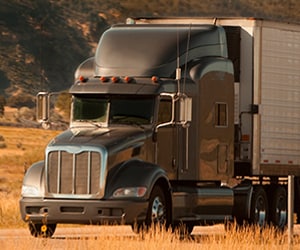
To make this possible, manufacturers are using these components – multi-function sensors, rugged connectors, fiber optic cabling, and heavy-duty cable assemblies – to integrate more dynamic connectivity. This enables innovation in interactive screens, integrated electrical architectures, and high-speed multimedia networks. As sensors collect and measure data about roadway and vehicle conditions, and then display this on interactive screens, drivers get quick real-time information to operate the vehicle. For passengers, they get easy access to real-time information so they can work, shop, watch films, and share their experiences on social media – directly from their seats.
This technology not only enables easy access to information, it is also automating data connectivity in systems for monitoring blind spots, roadway conditions, and engine performance. This level of integration enables the vehicle to reliably communicate with passenger devices, other vehicles, transportation networks, and road and rail infrastructure, such as toll booths, smart streetlights, and train stations. Inside the vehicles, this technology powers cameras that detect drowsy drivers, monitor passenger activities, and manage audio and environmental systems to provide passengers with a comfortable, enjoyable travel experience. This technology – and the IoT thinking making it possible – is enabling data connectivity to bus terminals, trucking depots, and railway stations.
For manufacturers, the challenge is finding components with the capacity for reliable high-speed connections in high-density packages for heavy-duty vehicles. For example, existing CAN bus protocols such as SAE J1939 lack the data speed and real-time updates required for a robust infotainment system to perform as expected. Trying to achieve innovation with conventional electronics can also significantly increase the vehicle’s overall weight and require more space to house additional components, which in turn increases power consumption and the possibility for more things to malfunction. This can overburden critical systems, causing unexpected breakdowns that increase operating costs.
To achieve wider bandwidths in heavy-vehicle technology, engineers need Low Voltage Differential Signaling (LVDS) and Ethernet (such as new 100Base-T1 or 1000Base-T1) solutions. These reduce cabling costs and increase operating data speed to support real time and highly accurate systems, such as in a railway’s modern onboard network. Getting this right in heavy-duty vehicles requires rugged, wear-resistant electrical components that support system performance and meet requirements for EMI/EMC and – particularly in the rail industry – fire and smoke.
Today, advanced connectivity is putting more IoT-enabled technology into heavy-duty transportation. This makes it possible to seamlessly integrate an infotainment system into the vehicle, for better driving and travelling experiences. Achieving this requires electronic components engineered to withstand the high-temperatures and high-vibrations of long-range heavy-duty transport.
Our sensors – for temperature, pressure, and humidity – detect and measure data crucial for enabling drivers to easily monitor vehicle performance, road conditions, and cargo.
Our interconnect systems support diagnostics and preventive responses. In commercial buses particularly, our RF connectors enable telemetry, surround view systems, and cloud computing.
In passenger railcars, our Multiple Unit (MU) connectors provide an efficient, single point for transmitting 27 data commands throughout the train. Also for rail, to address the fact that equipment data networks are growing several times faster than the rail market, our M12 solutions are solving several design challenges: Our M12 connectors offer endless combinations of cable assemblies with customer-specific cables or predefined cables with variable lengths; our M12 cable assemblies enable more digitization in rail data communication systems by supporting data speeds up to 10 Gb/s; and our M12 Ethernet switches – designed with redundant input power and an optional bypass to deliver uninterrupted network performance – support data speeds of up to 1 Gb/s and function as nodes in networks, providing connection ports to devices such as CCTV cameras, passenger information systems, sensors, lighting, HVAC, and more.
These types of components, when used to integrate infotainment systems into the technology architecture for heavy-transport vehicles, expand system capacity – without sacrificing signal integrity, data throughput, and power performance.
Infotainment in Smart CitiesIn cities worldwide, building owners and municipalities are installing interactive infotainment systems that connect people to dynamic information and create digital experiences that enrich our everyday lives. These types of systems are also crucial for increasing occupancy, improving operations, and enhancing the overall experience of public spaces.

Next-generation infotainment systems could help people connect to their environments, by maximizing the potential of always-available connectivity for robust data-everywhere integration.
While often very similar to infotainment systems in cars, airplanes, and heavy-transport vehicles, these systems serve the backbone for operating complex information networks in smart cities and intelligent buildings. This technology can support security systems, LED lighting, smart parking, and traffic control. When integrated, these can help improve overall energy efficiency, reduce congestion, and enable increased control. Where these infotainment systems currently fall short is maximizing the potential of always-available connectivity for robust data-everywhere integration. What’s needed is a better way to transmit information to people about their environment, in ways that leverage innovation around augmented reality (AR) and real-time video delivered directly to smartphones, video screens, and interactive kiosks.
In a fully realized connected public space and tech-smart building, there could be a nearly endless array of dynamic access to a broad range of video, text, and audio content, including environmental data and personalized information delivered across high-speed, low-latency networks improving data infrastructures and data orchestration.
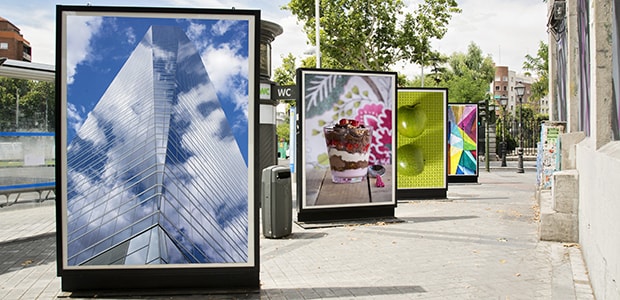
Designing infotainment systems for cityscapes requires thinking beyond package design, with a focus on how these networks integrate across very large and complex technological ecosystems.
Digital Infrastructure (High-Speed / Ultralow-Latency Network)
Network architectures in wireless and cellular devices are expected to change drastically over the next few years. More computing will be done at the “edge” in order to reduce network latency while powering a world increasingly dependent on IoT connectivity and opportunities. Currently, many cities lack the kind of high-speed, low-latency networks needed to reliably and seamlessly connect a large number of devices at once.
As 5G networks rollout over the next few years, these have the potential to enable more devices working in concert, allowing people to interact with their environment through multiple channels simultaneously. Making this happen means that technology companies as well as building owners and municipalities will need to look for new ways to support more robust communications, possibly using smaller, higher density infotainment systems to enable truly autonomous data connectivity – such as in cars – with the functionality to navigate different environments under continuously changing conditions, and with the capacity to quickly and simultaneously communicate with other technology, such as other vehicles, buildings, traffic lights, and more.
At TE, our engineers are working closely with technology startups and manufacturing leaders to enable 5G connectivity in technology that helps improve our lives, that takes new concepts from design to real-world application, that pushes computing and data processing to the edge of what’s possible.
Data Orchestration
When the 5G network launches, it will enable multi-gigabit speeds and massive capacity over short distances, creating a fertile environment for new applications and use cases. To take advantage of this capacity, municipalities and building owners will need to rethink their technological architectures so that they can generate advantages from intelligent data orchestration.
The major challenge facing engineers today is how to extract, process, analyze, and update IoT data efficiently and effectively. There are many use-cases which demonstrate that cloud communication does not always make sense. For example, if an autonomous vehicle is reliant on a cloud processing step to function, it could involve a connection that fails and jeopardizes passenger safety. In this circumstance, network latency could render the data captured irrelevant by the time it is processed and returned.
In a 5G network, machines will need the capacity to accelerate data transfer between devices, on the edge and the cloud. Only with an effective data orchestration and management strategy will a 5G network provide capacity that enables cities and buildings to become truly “smart.”

Geo-synchronous satellites can take data transmission to the next level, such as improving navigational systems in smart cities.
Designing infotainment systems for cityscapes and building requires thinking beyond package design, with a focus on how these networks integrate across very large and complex technological ecosystems. This means looking at how geo-synchronous satellites can take data transmission to the next level, such as improving navigational systems in smart cities.
Advanced connectivity can enable satellites to play a role in 5G communications and IoT connectivity. In satellites, our space-rated temperature sensors monitor the temperature of components exposed to solar radiation (hot) and the dark side of satellites (cold), ensuring effective high-speed performance. Our LVDT position sensors very accurately control the position of mini-thrusters which in turn control and maintain a satellite’s position above the earth.
At TE, our engineers are working with companies large and small (from manufacturing leaders to technology entrepreneurs) to help them create opportunities for integrating new technologies – artificial intelligence, autonomous processes, tracking of everything everywhere – into infotainment systems that make information more available to people everywhere, anywhere they travel, live, and work.
Building Future-Ready Technology
With 5G on the horizon, and IoT becoming a greater part of our everyday lives, the global demand for integrated technology is expected to continue rising. For manufacturers, there are still several challenges to solve before the possibilities of innovation are made real. For example, as speeds in all digital parts of 5G increases, power consumption will proportionally increase, as will overall costs.
And as the number of IoT-enabled technologies increase, engineers will need to resolve how these new technologies – with multiple sensing functions – effectively and efficiently process information quickly enough to make the hyperscale data acquisition useful for machines, networks, and people.
Achieving this kind of performance is still more art than science. It begins with putting robust connectivity into system architectures. This means engineers need rugged electronic components built to provide the speed, clarity, and bandwidth needed to run new algorithms for machine learning. With TE's comprehensive portfolio of advanced connectivity solutions – including high-speed connectors and innovative sensor combinations, lightweight fiber optic solutions and miniature packaging, multicore cable and EMI filters, engineers can achieve this kind of innovation.
In infotainment systems, our solutions enable faster network speed at the edge, making possible real-time data integration, greater data aggregation, and autonomous management of complex technology in high-density harsh environments. For infotainment manufacturers, our solutions open doors for generating business value – from interactive infotainment applications engineered for immersive engagement with real-time information, on-demand entertainment, and artificial intelligence – in cars, airplanes, buses and trucks, trains, and high-use buildings and public spaces.

Next-generation infotainment systems could put more robust connectivity into the technological architectures of the devices, machines, and networks that are changing how we travel, live, and communicate.
Future-Ready Connectivity
Across TE, our engineering, product, and manufacturing teams are investigating and developing solutions to advance electronic components – in design, materials science, and integrated circuitry, all areas TE specializes in. Worldwide, manufacturers rely on our high-speed, lightweight, miniaturized components to build lighter, smaller infotainment systems offering the high-clarity, ultralow-latency performance needed to achieve business advantages and drive cost competitiveness, particularly as volumes increase. With our broad range of electronic components, manufacturers are integrating future-ready connectivity into complex infotainment systems engineered for function, safety, link type, and efficiency. Together, we are building robust architectures and applying IoT thinking to enable end-to-end digital experiences– on the roads and rails, in the air and the city. Together, we are partnering to accelerate the commercialization of a new generation of infotainment systems designed for convenience, integration, and productivity.
About the Author
More Content by TE Connectivity





















